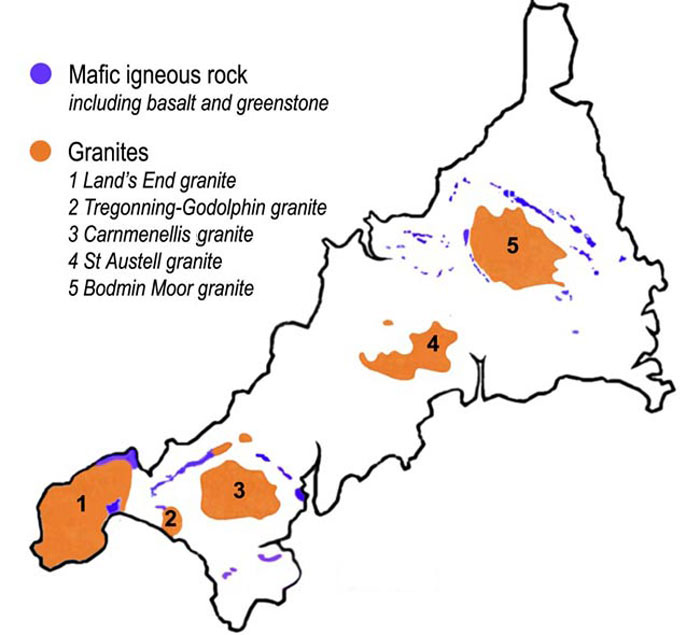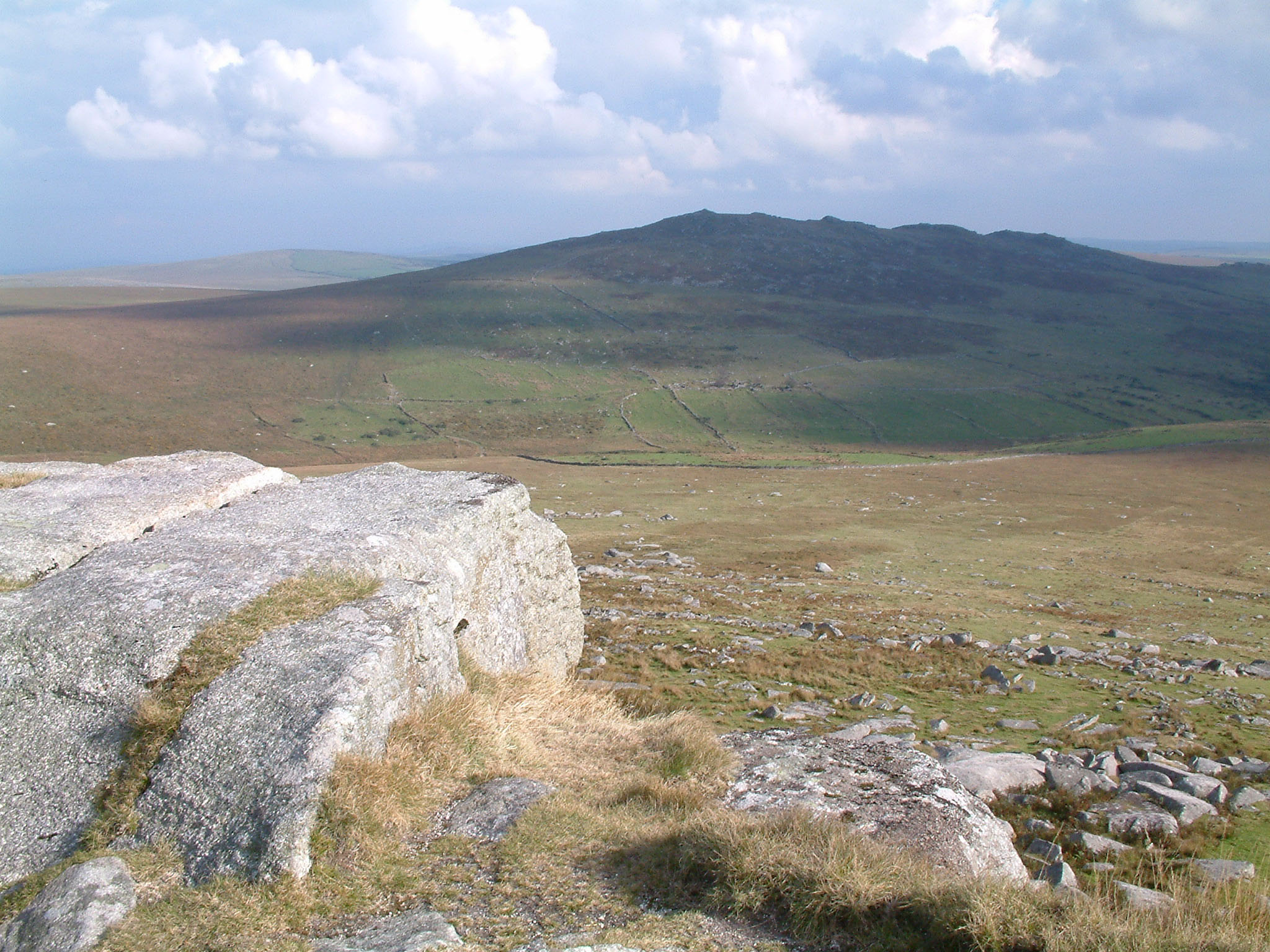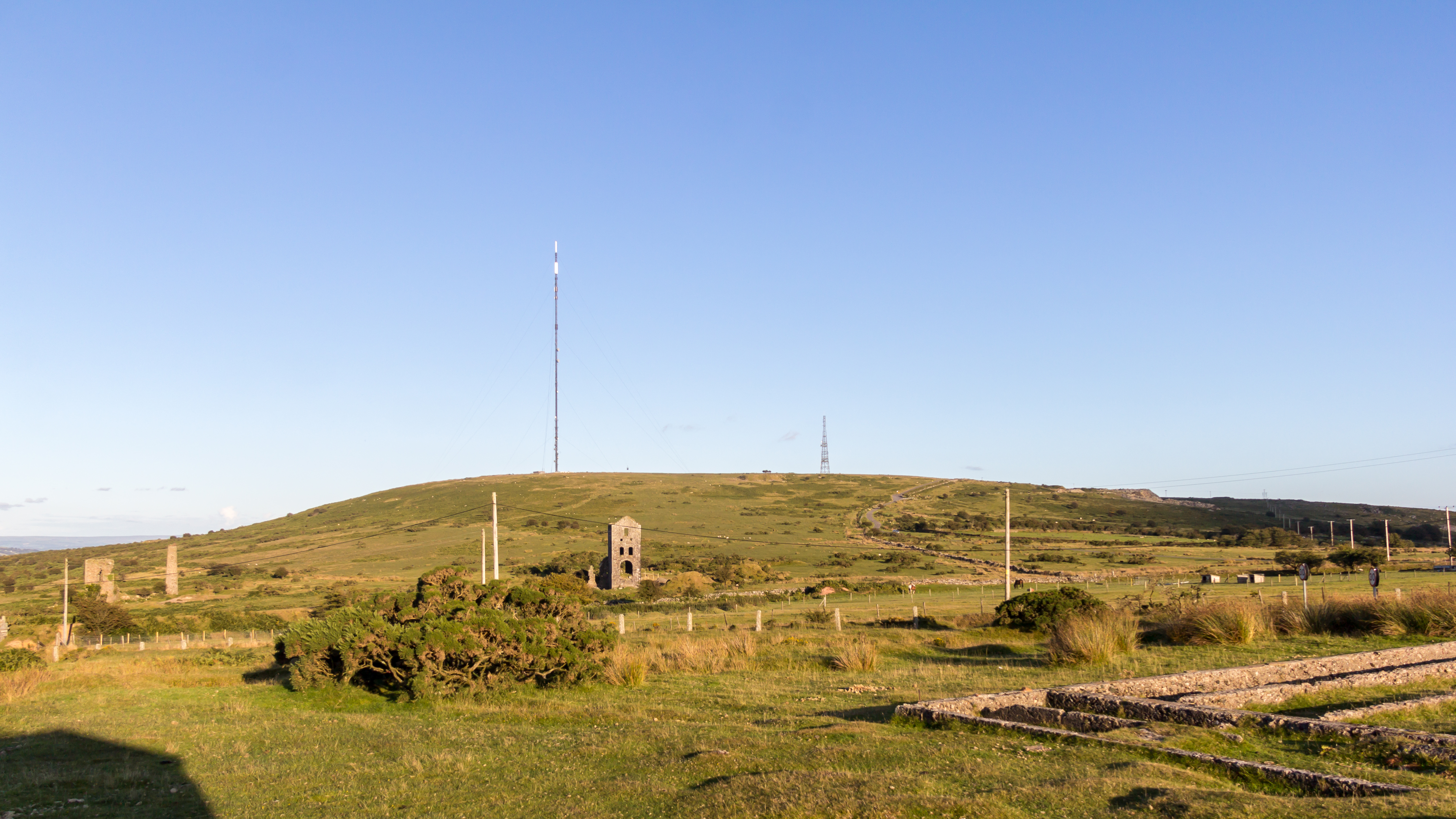|
Bodmin Moor
Bodmin Moor ( kw, Goon Brenn) is a granite moorland in north-eastern Cornwall, England. It is in size, and dates from the Carboniferous period of geological history. It includes Brown Willy, the highest point in Cornwall, and Rough Tor, a slightly lower peak. Many of Cornwall's rivers have their sources here. It has been inhabited since at least the Neolithic era, when primitive farmers started clearing trees and farming the land. They left their megalithic monuments, hut circles and cairns, and the Bronze Age culture that followed left further cairns, and more stone circles and stone rows. By medieval and modern times, nearly all the forest was gone and livestock rearing predominated. The name Bodmin Moor is relatively recent. An early mention is in the ''Royal Cornwall Gazette'' of 28 November 1812. The upland area was formerly known as Fowey Moor after the River Fowey, which rises within it. Geology Bodmin Moor is one of five granite plutons in Cornwall that make up pa ... [...More Info...] [...Related Items...] OR: [Wikipedia] [Google] [Baidu] |
Permian
The Permian ( ) is a geologic period and stratigraphic system which spans 47 million years from the end of the Carboniferous Period million years ago (Mya), to the beginning of the Triassic Period 251.9 Mya. It is the last period of the Paleozoic Era; the following Triassic Period belongs to the Mesozoic Era. The concept of the Permian was introduced in 1841 by geologist Sir Roderick Murchison, who named it after the region of Perm in Russia. The Permian witnessed the diversification of the two groups of amniotes, the synapsids and the sauropsids ( reptiles). The world at the time was dominated by the supercontinent Pangaea, which had formed due to the collision of Euramerica and Gondwana during the Carboniferous. Pangaea was surrounded by the superocean Panthalassa. The Carboniferous rainforest collapse left behind vast regions of desert within the continental interior. Amniotes, which could better cope with these drier conditions, rose to dominance in place of their am ... [...More Info...] [...Related Items...] OR: [Wikipedia] [Google] [Baidu] |
Natural England
Natural England is a non-departmental public body in the United Kingdom sponsored by the Department for Environment, Food and Rural Affairs. It is responsible for ensuring that England's natural environment, including its land, flora and fauna, freshwater and marine environments, geology and soils, are protected and improved. It also has a responsibility to help people enjoy, understand and access the natural environment. Natural England focuses its activities and resources on four strategic outcomes: * a healthy natural environment * enjoyment of the natural environment * sustainable use of the natural environment * a secure environmental future Roles and responsibilities As a non-departmental public body (NDPB), Natural England is independent of government. However, the Secretary of State for Environment, Food & Rural Affairs has the legal power to issue guidance to Natural England on various matters, a constraint that was not placed on its predecessor NDPBs. Its powers inc ... [...More Info...] [...Related Items...] OR: [Wikipedia] [Google] [Baidu] |
Site Of Special Scientific Interest
A Site of Special Scientific Interest (SSSI) in Great Britain or an Area of Special Scientific Interest (ASSI) in the Isle of Man and Northern Ireland is a conservation designation denoting a protected area in the United Kingdom and Isle of Man. SSSI/ASSIs are the basic building block of site-based nature conservation legislation and most other legal nature/geological conservation designations in the United Kingdom are based upon them, including national nature reserves, Ramsar sites, Special Protection Areas, and Special Areas of Conservation. The acronym "SSSI" is often pronounced "triple-S I". Selection and conservation Sites notified for their biological interest are known as Biological SSSIs (or ASSIs), and those notified for geological or physiographic interest are Geological SSSIs (or ASSIs). Sites may be divided into management units, with some areas including units that are noted for both biological and geological interest. Biological Biological SSSI/ASSIs may ... [...More Info...] [...Related Items...] OR: [Wikipedia] [Google] [Baidu] |
List Of Hills Of Cornwall
This is a list of hills in Cornwall based on data compiled in various sources, but particularly th''Database of British and Irish Hills'' Jackson's ''More Relative Hills of Britain'' and the Ordnance Survey 1:25,000 ''Explorer'' and 1:50,000 ''Landranger'' map series. Many of these hills are important historic, archaeological and nature conservation sites, as well as popular hiking and tourist destinations in the county of Cornwall in southwest England. Colour key The table is colour-coded based on the classification or "listing" of the hill. The three types that occur in Cornwall are Marilyns, HuMPs and TuMPs, listings based on topographical prominence. "Prominence" correlates strongly with the subjective significance of a summit. Peaks with low prominences are either subsidiary tops of a higher summit or relatively insignificant independent summits. Peaks with high prominences tend to be the highest points around and likely to have extraordinary views. A Marilyn is a hill wit ... [...More Info...] [...Related Items...] OR: [Wikipedia] [Google] [Baidu] |
Caradon Hill
Caradon Hill ( kw, Bre Garn) is on Bodmin Moor in the former Caradon district of Cornwall, England, United Kingdom. The summit is above mean sea level. Caradon Hill is on the southeastern edge of the moor; it is between the villages of Minions (northwest), Upton Cross (northeast), Pensilva (southeast) and Darite (southwest). The hill was once famous for its copper mines but these are now closed. The South Caradon Copper Mine, 1 km to the SW of the transmitter, was the biggest copper mine in the UK in its heyday in the second half of the 19th century. Other disused copper and tin mines are scattered around the base of the hill, including the Wheal Phoenix, well known among mineral collectors. The ruins of the Prince of Wales engine house are prominent at Wheal Phoenix. at < ... [...More Info...] [...Related Items...] OR: [Wikipedia] [Google] [Baidu] |
Kilmar Tor
Kilmar Tor (''Cornish: Kil Margh'') is an elongated hill, high and running from SW to NE, on Bodmin Moor in the county of Cornwall, England.Ordnance Survey 1:25,000 ''Explorer'' map series, No. 109 Its prominence of 118 metres qualifies it as a HuMP. Kilmar Tor is located on the eastern side of Bodmin Moor, about 2½ kilometres WSW of the hamlet of North Hill and 3½ kilometres north of Cornwall's highest village, Minions. It is surmounted by granite tors. There is trig point at the summit as well as a cairn and cist. The course of a dismantled railway runs around the hill to the south, evidence of the mining that used to be carried out in the area. On Kilmar Tor's northern flank is Twelve Men's Moor with Trewortha Tor and Hawk's Tor beyond the saddle. To the southeast is Bearah Tor and, to the south, Langstone Downs. Withy Brook runs roughly north to south past the western end of the hill and, to the east, open moorland descends to the valley of the River Lynher. Po ... [...More Info...] [...Related Items...] OR: [Wikipedia] [Google] [Baidu] |
Tor (rock Formation)
A tor, which is also known by geomorphologists as either a castle koppie or kopje, is a large, free-standing rock outcrop that rises abruptly from the surrounding smooth and gentle slopes of a rounded hill summit or ridge crest. In the South West of England, the term is commonly also used for the hills themselves – particularly the high points of Dartmoor in Devon and Bodmin Moor in Cornwall.Ehlen, J. (2004) ''Tor'' in Goudie, A., ed., pp. 1054-1056. ''Encyclopedia of Geomorphology.'' Routledge. London, England. Etymology Although English topographical names often have a Celtic etymology, the Oxford English Dictionary lists no cognates to the Old English word in either the Breton or Cornish languages (the Scottish Gaelic ''tòrr'' is thought to derive from the Old English word). It is therefore accepted that the English word ''Tor'' derives from the Old Welsh word ''tẁrr'' or ''twr'', meaning a cluster or heap. Formation Tors are landforms created by the erosion and weath ... [...More Info...] [...Related Items...] OR: [Wikipedia] [Google] [Baidu] |
Geology Of Cornwall
The geology of Cornwall, England, is dominated by its granite backbone, part of the Cornubian batholith, formed during the Variscan orogeny. Around this is an extensive metamorphic aureole (known locally as killas) formed in the mainly Devonian slates that make up most of the rest of the county. There is an area of sandstone and shale of Carboniferous age in the north east, and the Lizard peninsula is formed of a rare section of uplifted oceanic crust. Coasts Cornwall forms the tip of the south-west peninsula of the island Great Britain, and is therefore exposed to the full force of the prevailing winds that blow in from the Atlantic Ocean. The coastline is composed mainly of resistant rocks that give rise in many places to impressive cliffs. The north and south coasts have different characteristics. The north coast is more exposed and therefore has a wilder nature. The prosaically-named ''High Cliff'', between Boscastle and St Gennys, is the highest sheer-drop cliff in Corn ... [...More Info...] [...Related Items...] OR: [Wikipedia] [Google] [Baidu] |
Holocene
The Holocene ( ) is the current geological epoch. It began approximately 11,650 cal years Before Present (), after the Last Glacial Period, which concluded with the Holocene glacial retreat. The Holocene and the preceding Pleistocene together form the Quaternary period. The Holocene has been identified with the current warm period, known as MIS 1. It is considered by some to be an interglacial period within the Pleistocene Epoch, called the Flandrian interglacial.Oxford University Press – Why Geography Matters: More Than Ever (book) – "Holocene Humanity" section https://books.google.com/books?id=7P0_sWIcBNsC The Holocene corresponds with the rapid proliferation, growth and impacts of the human species worldwide, including all of its written history, technological revolutions, development of major civilizations, and overall significant transition towards urban living in the present. The human impact on modern-era Earth and its ecosystems may be considered of global si ... [...More Info...] [...Related Items...] OR: [Wikipedia] [Google] [Baidu] |
Blockfield
A blockfieldWhittow, John (1984). ''Dictionary of Physical Geography''. London: Penguin, 1984, pp. 66 and 190. . (also spelt block fieldLeser, Hartmut, ed. (2005). ''Wörterbuch Allgemeine Geographie'', 13th ed., dtv, Munich, pp. 107 and 221. . ), felsenmeer, boulder field or stone field is a surface covered by boulder- or block-sized angular rocks usually associated with alpine and subpolar climates and periglaciation. Blockfields differ from screes and talus slope in that blockfields do not apparently originate from mass wastings. They are believed to be formed by frost weathering below the surface. An alternative theory that modern blockfields may have originated from chemical weathering that occurred in the Neogene when the climate was relatively warmer. Following this thought the blockfields would then have been reworked by periglacial action. Most known blockfields are located in the northern hemisphere. Examples can be found in Abisko National Park in Sweden, Snowdonia ... [...More Info...] [...Related Items...] OR: [Wikipedia] [Google] [Baidu] |
Peat
Peat (), also known as turf (), is an accumulation of partially decayed vegetation or organic matter. It is unique to natural areas called peatlands, bogs, mires, moors, or muskegs. The peatland ecosystem covers and is the most efficient carbon sink on the planet, because peatland plants capture carbon dioxide (CO2) naturally released from the peat, maintaining an equilibrium. In natural peatlands, the "annual rate of biomass production is greater than the rate of decomposition", but it takes "thousands of years for peatlands to develop the deposits of , which is the average depth of the boreal orthernpeatlands", which store around 415 gigatonnes (Gt) of carbon (about 46 times 2019 global CO2 emissions). Globally, peat stores up to 550 Gt of carbon, 42% of all soil carbon, which exceeds the carbon stored in all other vegetation types, including the world's forests, although it covers just 3% of the land's surface. ''Sphagnum'' moss, also called peat moss, is one of th ... [...More Info...] [...Related Items...] OR: [Wikipedia] [Google] [Baidu] |









.jpg)